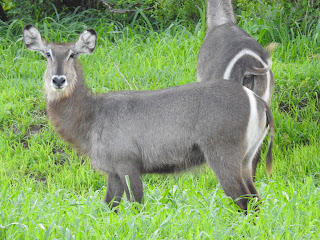The go-away bird's call sounds somewhat like the words 'go away'.
The spotted, yellow back of this village weaver male distinguishes it from other weavers
The Victoria Falls area is the Northern grey sparrow's stronghold in Southern Africa
The African grey hornbill was one of 4 hornbill species we were to see on the trip
Southern red-billed hornbills protect their young by imprisoning them in their nest
The sundevalli subspecies of warthog is present in Zimbabwe and Botswana
Dark-capped bulbuls seemed to be the area's most common bird
The red-headed weaver is quite common in the woodland along the Zambezi
White-browed sparrow-weaver nests dotted the trees on the road towards the lodge
After a hearty breakfast, we were driven to Victoria Falls. We walked around the falls and viewed their beauty from several points. We were entirely soaked by spray while doing this, to the point where we should probably have brought bathers. Thankfully, we were given ponchos to protect both ourselves and our cameras. The magnificence of the falls far made up for this small inconvenience. On the birding side, arriving in the early morning allowed us to see several white-browed robin chats in the undergrowth, a small flock of Hadeda ibis flying overhead, a hiding black-collared barbet and many red-winged starlings. Though others briefly saw a terrestrial brownbul, I was not able to get a look at it. As for mammals, we saw several rather tame bushbuck. The early morning arrival also allowed us to avoid most of the crowds.
The view from Danger Point, the viewpoint closest to the Zimbabwe border
This area of the falls is known as Devil's Cataract. The land to the right is Cataract Island.
The spray from this section of the falls rained down on us as we walked through the forest.
You can tell this bushbuck is female as it lacks the male's horns
A red-winged starling poses in front of the cliffs of the falls
Upon arrival back at the lodge, we relaxed for a while before making our way to a hide. Here we were to view the lodge's vulture restaurant: at 1 pm, every day, meat is left out for the local population of vultures to feed on. Almost immediately we could see hundreds of vultures filling the sky above the lodge. Several white-backed and hooded vultures had perched in the trees surrounding the restaurant, waiting hungrily. There were even some yellow-billed kites patiently flying around the restaurant, ready for their chance to try and scavenge whatever the vultures left over. Pieces of impala were laid out on the ground, and immediately hundreds of vultures leapt onto the corpse and started to tear at it.
Hundreds of white-backed and hooded vultures were circling above the restaurant
These two white-backed and hooded vultures sat in a tree just left of the restaurant
As our guide put the corpse down, hundreds of white-backed vultures circled him
There was immediately a throng of white-backed vultures tearing at the kill
The weaker white-backed and hooded vultures were forced to eat the leftovers
We were told that later in the night spotted hyenas would visit the corpse for any leftover bones, but we were too tired to stay up that long and didn't get to see them.Our next activity was a cruise down the Zambezi River. We left at around 3.30 and boarded the boat. It was less productive than I thought it'd be, but we still saw a good deal of birds. We got good views of a young Nile crocodile and some hippos, along with some bushbuck and distant vervet monkeys on a nearby island. Bird-wise the best sighting was a goliath heron that I didn't get any particularly good photos of. Hammerkop, reed cormorants, African darters, African openbills and pied kingfishers were common along the banks of the river. Dead trees held resting white-backed vultures, hooded vultures and yellow-billed kites. Several pearl-breasted swallows were flying around the boat. Finally, while stopping to look at a large Nile crocodile hidden by some small trees, we got a nice look at an emerald-spotted wood dove.
The African openbill seemed to be just as common as its Asian cousin
The hippo is another extremely dangerous animal due to how territorial it is
Emerald-spotted wood doves are much smaller than most of the area's other doves
The chestnut stripe on this African darter's throat shows that it is a male
This small Nile crocodile was sunning itself on a hippo trail
This reed cormorant is in its pale non-breeding plumage
We then headed back to the lodge and slept.

























































